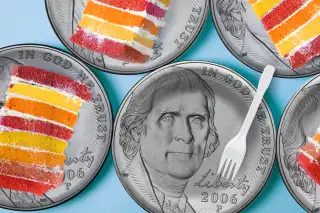5 Pretty Amazing Facts About the Nickel on Its 150th Anniversary

It was 150 years ago this month (May 16, 1866, to be exact) that Congress authorized the creation of a new five-cent coin made of nickel and copper.
Those first nickels, as they came to be known, featured a large number 5 surrounded by stars on one side, with an elaborate, striped shield on the other.
Reviewing the so-called shield nickel, a writer for the American Journal of Numismatics was unimpressed, calling it “the ugliest of all known coins” and “despicable” “both in design and execution.”
Later nickels would be better received, with their portraits of Lady Liberty (1883 to 1913), a Native American/buffalo combo (1913 to 1938), and Thomas Jefferson (1938 to today).
Here, in honor of its century and a half of service to America, are five facts about the five-cent piece:
1. The first nickels weren’t worth a nickel. Because so many jittery Americans hoarded silver coins during the Civil War, the U.S. Treasury had to come up with an alternative way to keep money in circulation. It tried issuing paper money in denominations as low as three cents, but that proved unwieldy. In 1865 it decided to create three-cent pieces made of the less-valuable metals of nickel and copper, in effect the first “nickels.” The following year, Congress authorized a five-cent nickel.
2. The nickel wasn’t our first five-cent coin. For seven decades before the arrival of the nickel, the U.S. had a five-cent silver coin known as the half-dime or half-disme (from an Old French word meaning a tenth). The 1792 half-dime was the first coin minted in the new nation, and, according to the U.S. Mint, the metal for the initial batch may have come from silverware owned by George and Martha Washington. (Presumably they had more at home.) Before then, the U.S. had paper money but relied on Spanish and English coins for pocket change.
3. A Coke cost a nickel for generations. The price of a 6.5-ounce bottle of Coca-Cola was fixed at 5 cents from 1885 until well into the 1950s. Most sugary-beverage historians set the last year at 1959, though others point to earlier dates. One reason for the company’s devotion to the five-cent price was that its vending machines only took nickels, and raising the cost from one nickel to two, a 100% increase, was unthinkable. Competitor Pepsi-Cola also kept its price at a nickel for many years but positioned itself as the better value with 12-ounce bottles and an inescapable jingle that boasted of “Twice as much for a nickel, too.” It wasn’t quite twice as much, but in those less-litigious times, no one seemed to care.
4. The nickel is the only coin likely to be worth more than face value. Pennies cost more than a cent to produce, but because they now carry only a thin coating of copper (since 1982, they’ve been 97.5% zinc), their metal content is worth less than their face value. That leaves the nickel (75% copper and 25% nickel) as the only current coin whose “meltdown value" sometimes exceeds its value as a coin, depending on commodity prices. Don’t get any ideas, though: Melting them down has been illegal since 2006.
5. Nickels are big with survivalists. Hoarding nickels is popular among survivalists, who believe that if civilization collapses, paper money will become worthless, but the nickel will at least retain the value of its metals. Hiding tons of the coins until the dread day comes may pose its own challenges, of course, but better safe than sorry.